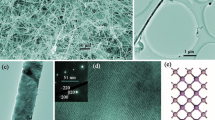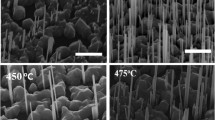Abstract
A simple self-catalyzed chemical vapor deposition process was conducted to synthesize single-crystalline GaSb nanowires, where Ga droplets were utilized as the catalysts. The as-grown GaSb nanowires exhibited typical p-type semiconductor behavior with the calculated hole mobility of about 0.042 cm2 V−1 s−1 The photoresponse properties of the GaSb nanowires were studied by fabricating nanowire photodetectors on both rigid and flexible substrates. The results revealed that the photodetectors exhibited broad spectral response ranging from ultraviolet, visible, to near infrared region. For the device on rigid substrate, the corresponding responsivity and the detectivity were calculated to be 3.86×103A W−1 and 3.15×1013 Jones for 500 nm light, and 7.22×102A W−1 and 5.90×1012 Jones for 808 nm light, respectively, which were the highest value compared with those of other reported Ga1−xInxAsySb1−y structure nanowires. Besides, the flexible photodetectors not only maintained the comparable good photoresponse properties as the rigid one, but also possessed excellent mechanical flexibility and stability. This study could facilitate the understanding on the fundamental characteristics of self-catalyzed grown GaSb nanowires and the design of functional nano-optoelectronic devices based on Gasb nanowires.
摘要
本文应用镓金属液滴作为催化剂, 采用化学气相沉积方法自催化合成了单晶GaSb纳米线. 研究表明该GaSb纳米线为典型的p型半导体, 霍尔迁移率为> 0.042 cm2 V−1 s−1. 硅基和柔性衬底上构筑的基于GaSb纳米线的光电探测器, 具有良好的紫外-可见-近红外宽光谱探测性能. 硅基器件对5 0 0 nm的可见光响应率可达3.86×103 A W−1, 探测率可达3.15×1013 Jones; 柔性器件在保持相似光电性能的同时, 具有极好的机械柔韧性和稳定性. 本文有助于更好地揭示自催化生长的GaSb纳米线的性能, 并为进一步设计基于GaSb纳米线的功能光电器件打下了实验基础.
Similar content being viewed by others
References
Novotny CJ, Yu ET, Yu PKL. InP nanowire/polymer hybrid photodiode. Nano Lett, 2008, 8: 775–779
Fang H, Hu W, Wang P, et al. Visible light-assisted high-performance mid-infrared photodetectors based on single InAs nanowire. Nano Lett, 2016, 16: 6416–6424
Guo N, Hu W, Liao L, et al. Anomalous and highly efficient InAs nanowire phototransistors based on majority carrier transport at room temperature. Adv Mater, 2014, 26: 8203–8209
Yang ZX, Han N, Fang M, et al. Surfactant-assisted chemical vapour deposition of high-performance small-diameter GaSb nanowires. Nat Commun, 2014, 5: 5249
Yang Z, Liu L, Yip SP, et al. Complementary metal oxide semiconductor-compatible, high-mobility, 111-oriented GaSb nanowires enabled by vapor-solid-solid chemical vapor deposition. ACS Nano, 2017, 11: 4237–4246
Ek M, Borg BM, Johansson J, et al. Diameter limitation in growth of III-Sb-containing nanowire heterostructures. ACS Nano, 2013, 7: 3668–3675
Yang Z, Yip SP, Li D, et al. Approaching the hole mobility limit of GaSb nanowires. ACS Nano, 2015, 9: 9268–9275
Luo T, Liang B, Liu Z, et al. Single-GaSb-nanowire-based room temperature photodetectors with broad spectral response. Sci Bull, 2015, 60: 101–108
Burke RA, Weng X, Kuo MW, et al. Growth and characterization of unintentionally doped GaSb nanowires. J Elec Mater, 2010, 39: 355–364
Pan D, Fan DX, Kang N, et al. Free-standing two-dimensional single-crystalline InSb nanosheets. Nano Lett, 2016, 16: 834–841
Mattias Borg B, Wernersson LE. Synthesis and properties of antimonide nanowires. Nanotechnology, 2013, 24: 202001
Zhang Y, Wu J, Aagesen M, et al. III–V nanowires and nanowire optoelectronic devices. J Phys D-Appl Phys, 2015, 48: 463001
Vurgaftman I, Meyer JR, Ram-Mohan LR. Band parameters for III–V compound semiconductors and their alloys. J Appl Phys, 2001, 89: 5815–5875
Liu Z, Luo T, Liang B, et al. High-detectivity InAs nanowire photodetectors with spectral response from ultraviolet to near-infrared. Nano Res, 2013, 6: 775–783
Plis EA, Kutty MN, Myers S, et al. Performance improvement of long-wave infrared InAs/GaSb strained-layer superlattice detectors through sulfur-based passivation. Infrared Phys Tech, 2012, 55: 216–219
Kim C, Kurosaki K, Muta H, et al. Thermoelectric properties of Zn-doped GaSb. J Appl Phys, 2012, 111: 043704
Ma L, Hu W, Zhang Q, et al. Room-temperature near-infrared photodetectors based on single heterojunction nanowires. Nano Lett, 2014, 14: 694–698
Yu X, Li L, Wang H, et al. Two-step fabrication of self-catalyzed Ga-based semiconductor nanowires on Si by molecular-beam epitaxy. Nanoscale, 2016, 8: 10615–10621
Guo YN, Zou J, Paladugu M, et al. Structural characteristics of GaSb/GaAs nanowire heterostructures grown by metal-organic chemical vapor deposition. Appl Phys Lett, 2006, 89: 231917
Schulz S, Schwartz M, Kuczkowski A, et al. Self-catalyzed growth of GaSb nanowires at low reaction temperatures. J Cryst Growth, 2010, 312: 1475–1480
Zamani RR, Gorji Ghalamestani S, Niu J, et al. Polarity and growth directions in Sn-seeded GaSb nanowires. Nanoscale, 2017, 9: 3159–3168
Jeppsson M, Dick KA, Nilsson HA, et al. Characterization of GaSb nanowires grown by MOVPE. J Cryst Growth, 2008, 310: 5119–5122
Ganjipour B, Nilsson HA, Mattias Borg B, et al. GaSb nanowire single-hole transistor. Appl Phys Lett, 2011, 99: 262104
Soci C, Zhang A, Xiang B, et al. ZnO nanowire UV photodetectors with high internal gain. Nano Lett, 2007, 7: 1003–1009
Chen G, Liang B, Liu X, et al. High-performance hybrid phenyl-C61-butyric acid methyl ester/Cd3P2 nanowire ultraviolet-visible-near infrared photodetectors. ACS Nano, 2014, 8: 787–796
Zhang K, Luo T, Chen H, et al. Au-nanoparticles-decorated Sb2S3 nanowire-based flexible ultraviolet/visible photodetectors. J Mater Chem C, 2017, 5: 3330–3335
Lou Z, Li L, Shen G. Ultraviolet/visible photodetectors with ultrafast, high photosensitivity based on 1D ZnS/CdS heterostructures. Nanoscale, 2016, 8: 5219–5225
Shen G, Chen PC, Bando Y, et al. Pearl-like ZnS-decorated InP nanowire heterostructures and their electric behaviors. Chem Mater, 2008, 20: 6779–6783
Wang X, Zhang Y, Chen X, et al. Ultrafast, superhigh gain visible-blind UV detector and optical logic gates based on nonpolar a-axial GaN nanowire. Nanoscale, 2014, 6: 12009–12017
Dutta PS, Bhat HL, Kumar V. The physics and technology of gallium antimonide: An emerging optoelectronic material. J Appl Phys, 1997, 81: 5821–5870
Cui Y, Duan X, Hu J, et al. Doping and electrical transport in silicon nanowires. J Phys Chem B, 2000, 104: 5213–5216
Yu G, Liang B, Huang H, et al. Contact printing of horizontally-aligned p-type Zn3P2 nanowire arrays for rigid and flexible photodetectors. Nanotechnology, 2013, 24: 095703
Gong X, Tong M, Xia Y, et al. High-detectivity polymer photo-detectors with spectral response from 300 nm to 1450 nm. Science, 2009, 325: 1665–1667
Miao J, Hu W, Guo N, et al. Single InAs nanowire room-temperature near-infrared photodetectors. ACS Nano, 2014, 8: 3628–3635
Zheng D, Wang J, Hu W, et al. When nanowires meet ultrahigh ferroelectric field-high-performance full-depleted nanowire photodetectors. Nano Lett, 2016, 16: 2548–2555
Tan H, Fan C, Ma L, et al. Single-crystalline InGaAs nanowires for room-temperature high-performance near-infrared photo-detectors. Nano-Micro Lett, 2016, 8: 29–35
Ma L, Zhang X, Li H, et al. Bandgap-engineered GaAsSb alloy nanowires for near-infrared photodetection at 1.31 µm. Semicond Sci Technol, 2015, 30: 105033
Li D, Lan C, Manikandan A, et al. Ultra-fast photodetectors based on high-mobility indium gallium antimonide nanowires. Nat Commun, 2019, 10: 1664
Chen X, Li H, Qi Z, et al. Synthesis and optoelectronic properties of quaternary GaInAsSb alloy nanosheets. Nanotechnology, 2016, 27: 505602
Li MZ, Chen XL, Li HL, et al. Optoelectronic properties of single-crystalline GaInAsSb quaternary alloy nanowires. Chin Phys B, 2018, 27: 078101
Liu Z, Xu J, Chen D, et al. Flexible electronics based on inorganic nanowires. Chem Soc Rev, 2015, 44: 161–192
Li L, Lou Z, Shen G. Hierarchical CdS nanowires based rigid and flexible photodetectors with ultrahigh sensitivity. ACS Appl Mater Interfaces, 2015, 7: 23507–23514
Acknowledgements
This work was supported by the National Natural Science Foundation of China (61574132 and 61625404).
Author information
Authors and Affiliations
Contributions
Author contributions Zhang K and Shen G designed the devices and experiments; Zhang K performed the experiments; Zhang K, Chai R, Shi R, and Lou Z analyzed the data; Zhang K wrote the paper with support from Shen G. All authors contributed to the general discussion.
Corresponding author
Ethics declarations
Conflict of interest The authors declare no conflict of interest.
Additional information
Kai Zhang received his PhD degree from the Institute of Semiconductors, Chinese Academy of Sciences in 2018. He joined Hebei University as an assistant professor in 2018. His current research focuses on low dimensional semiconductor electronics, including transistors, photodetectors, photovoltaic and lasers.
Guozhen Shen received his BSc degree in 1999 from Anhui Normal University and PhD degree in 2003 from the University of Science and Technology of China. From 2004 to 2013, he conducted his research in Hanyang University (Korea), National Institute for Materials Science (Japan), University of Southern California (USA) and Huazhong University of Science and technology (China). He joined the Institute of Semiconductors, Chinese Academy of Sciences as a professor in 2013. His current research focuses on flexible electronics and printable electronics, including transistors, photodetectors, sensors and flexible energy-storage devices.
Electronic supplementary material
Rights and permissions
About this article
Cite this article
Zhang, K., Chai, R., Shi, R. et al. Self-catalyzed growth of GaSb nanowires for high performance ultraviolet-visible-near infrared photodetectors. Sci. China Mater. 63, 383–391 (2020). https://doi.org/10.1007/s40843-019-1189-7
Received:
Accepted:
Published:
Issue Date:
DOI: https://doi.org/10.1007/s40843-019-1189-7




